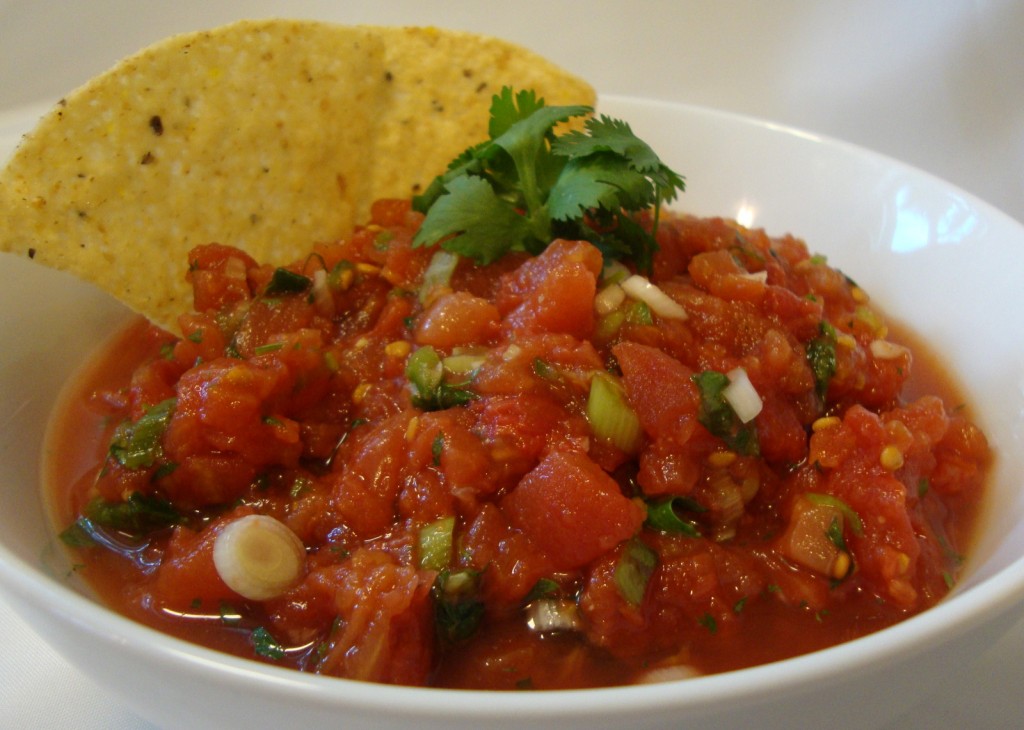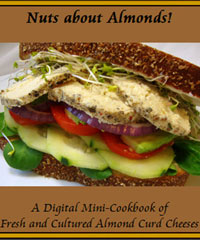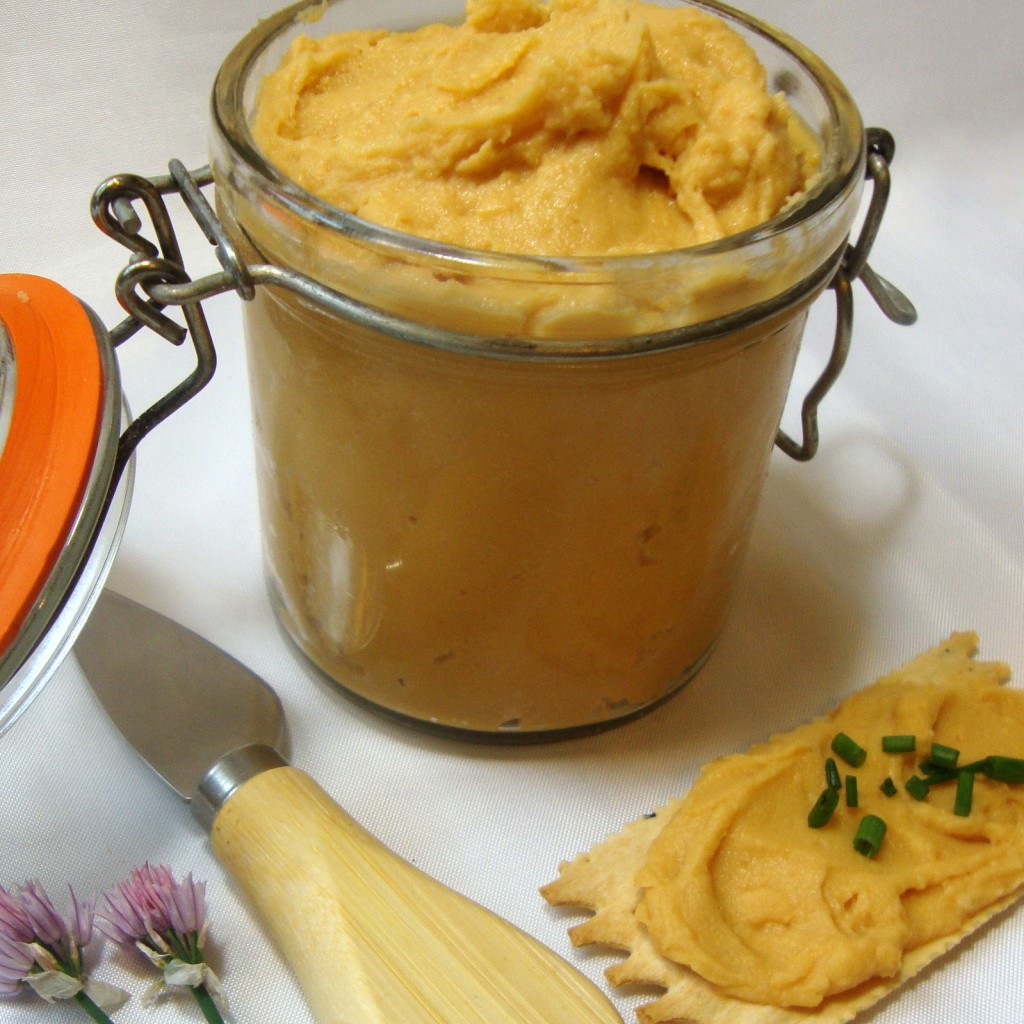 Crock Beer Cheese is a spreadable sharp non-dairy cheddar enhanced with the flavor of beer. The beer is first reduced to eliminate the alcohol and a good portion of the water thus concentrating its flavor (the beer flavor is not a primary note in the cheese but rather contributes to the overall flavor profile). To spice things up, ground cayenne pepper can be added before cooking the cheese. For a robust cheese, prepared horseradish can be mixed into the cheese after it has set.
Crock Beer Cheese is a spreadable sharp non-dairy cheddar enhanced with the flavor of beer. The beer is first reduced to eliminate the alcohol and a good portion of the water thus concentrating its flavor (the beer flavor is not a primary note in the cheese but rather contributes to the overall flavor profile). To spice things up, ground cayenne pepper can be added before cooking the cheese. For a robust cheese, prepared horseradish can be mixed into the cheese after it has set.
Crock Beer Cheese is superb for spreading on crackers, hard or soft pretzels or chunks of crusty bread. It can be melted on sandwiches or used in any application where spreadable sharp cheddar might be used.
Note: For this cheese, you will need a working understanding for preparing the Block Cheeses in the Non-Dairy Evolution Cookbook (see the main page of the TheGentleChef.com website for information on where to purchase the book). A cheese form is not required since the cheese will be stored in a crock or other suitable container. Any heat-proof container that will hold a minimum of 2 cups liquid will suffice for chilling and setting the cheese.
Ingredients
• 1 bottle (12 oz) beer of your choice, alcoholic or non-alcoholic
(please note that dark beers will darken the cheese)
• 1 T raw apple cider vinegar
• ½ tsp vegan lactic acid powder (available from ModernistPantry.com) or 2 tsp fresh lemon juice
• ½ cup refined coconut oil
• 1 cup organic plain unsweetened soymilk (no additives) or homemade almond milk
• ¼ cup tapioca flour
• ¼ cup nutritional yeast flakes
• 2 T mellow white miso paste
• 1 T tomato paste
• 2 tsp kappa carrageenan (available from ModernistPantry.com)
• 1 tsp fine sea salt or kosher salt
• 1 tsp dry ground mustard
• ½ tsp onion powder
• ½ tsp garlic powder
• optional: ¼ tsp ground cayenne pepper, or more to taste
• optional: 1 T prepared horseradish (not creamed) for stirring into the cheese after cooking and chilling
Technique:
First, gather all ingredients. Combine the vinegar with the lactic acid powder or lemon juice in a small dish and set aside near your cooking area. The acid mixture will be added to the cheese mixture after cooking.
Next, melt the coconut oil. Measure ½ cup and set aside.
In a medium saucepan, bring the beer to a simmer. Watch carefully while heating, as the beer will foam excessively and possibly boil over if brought to a vigorous boil. Skim and discard any excess foam. Simmer until reduced, about 15 minutes. Let the mixture cool until warm. Measure ⅓ cup and discard any remainder.
Transfer the beer reduction to a blender. Add the soymilk or almond milk with the remaining ingredients (except for the optional horseradish). Do not add the coconut oil or acid to the blender. Process the contents until smooth, stopping as necessary to dislodge any dry powder from the sides of the blender with a flexible spatula.
Now add the coconut oil (but not the acid) to the blender and pulse the mixture once or twice only to disperse the oil but not completely blend. This is important. After pulsing, pour the mixture into the saucepan.
Cook the cheese according to the Preparation and Cooking Technique instructions in the Block Cheese section of The Non-Dairy Evolution Cookbook. Be sure to incorporate the acid mixture into the cooked cheese before pouring into a minimum 2-cup container to set.
Cover with plastic wrap and chill for a minimum of 6 hours. After chilling, transfer the set cheese to a mixing bowl and mash and stir thoroughly with a fork until smooth. Stir in the optional prepared horseradish. Transfer to a crock or other suitable container and chill until ready to serve.
Print Recipe
Crock Beer Cheese (Non-dairy, of course)
Votes: 10
Rating: 4.8
You:
Rate this recipe!
|
|
Votes: 10
Rating: 4.8
You:
Rate this recipe!
|
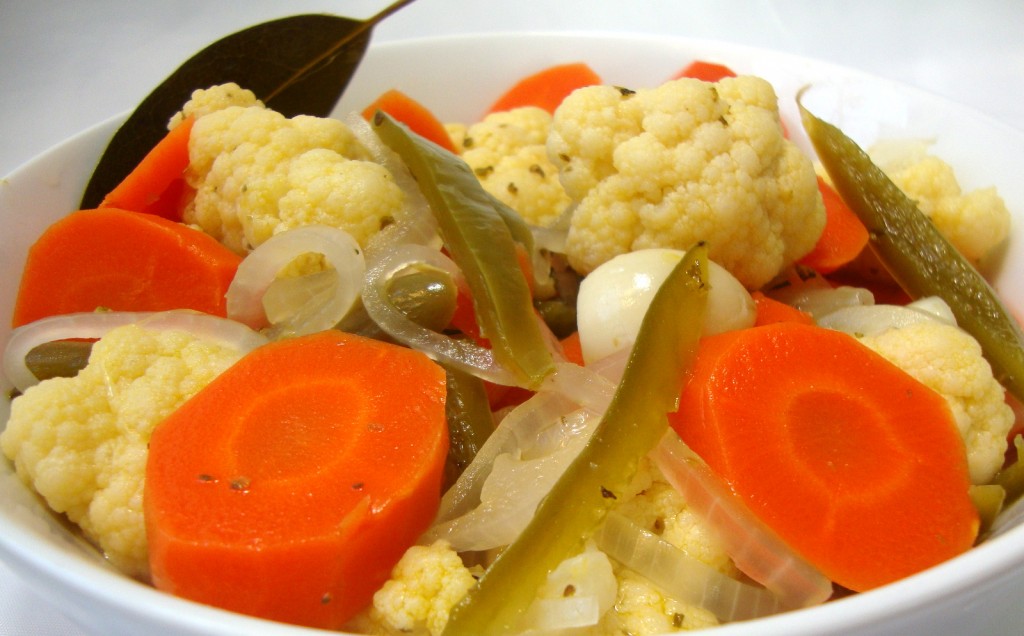 “Escabeche” is the Spanish word for “pickle”. This simple but zesty combination of crunchy pickled vegetables is a favorite for serving with Mexican cuisine.
“Escabeche” is the Spanish word for “pickle”. This simple but zesty combination of crunchy pickled vegetables is a favorite for serving with Mexican cuisine.
Ingredients
• 2 T olive oil
• 1 large yellow or white onion, peeled and thinly sliced
• 3 large carrots, peeled and sliced
• florets from 1 small cauliflower
• 12 whole cloves garlic
• 3 large jalapeno or serrano chilies, seeded, membrane removed and sliced lengthwise into slivers
• 3 T coarse sea salt or kosher salt
• 2 and ½ cups water
• 1 cup champagne vinegar, white wine vinegar or distilled white vinegar
• 1 T organic sugar
• 2 bay leaves
• ½ tsp dried oregano
• ½ tsp dried marjoram
• ½ tsp dried thyme
Technique
Add the olive oil to a large cooking pot and place over medium-low heat. Add the vegetables and salt and sweat the mixture for about 10 minutes until softened. Keep the heat on the low side to avoid browning the vegetables.
Add the water, vinegar, sugar and herbs and bring to a rapid boil. Cover the pot and remove from the heat to cool. When cooled, divide the mixture between 2 one-quart jars (be sure to include a bay leaf into each jar), seal and refrigerate for a minimum of 3 days before serving (the longer the better). The refrigerated escabeche will last for a few months stored in this manner.
To seal the jars and preserve the escabeche for pantry storage, removing the pot from the heat. Carefully divide the hot mixture between 2 one-quart mason jars (be sure to include a bay leaf in each jar). Put the lids in place and tighten the lid rings. Invert the jars for 10 minutes. After 10 minutes, upright the jars and slightly loosen the lid rings. Let the jars rest and cool until the lids “pop” and seal shut. Retighten the lid rings and store the jars in your pantry until ready to use.
Print Recipe
Escabeche (Mexican Spicy Pickled Vegetables)
Votes: 236
Rating: 3.91
You:
Rate this recipe!
|
|
Votes: 236
Rating: 3.91
You:
Rate this recipe!
|
 Although many people consider tomatoes to be a vegetable, they’re actually a fruit; so why not make them into jam? Actually, tomato jam is more like a relish than a true jam. My partner Chef Mike and I created this blend one Sunday afternoon and we were thrilled with the lovely balance of sweet, tangy and smoky flavors. This jam is wonderful when used as an alternative to ketchup on veggie burgers and hot dogs. It’s also excellent when served with cheese, such as non-dairy chèvre, on crostini or crusty bread. This recipe yields about 2 cups.
Although many people consider tomatoes to be a vegetable, they’re actually a fruit; so why not make them into jam? Actually, tomato jam is more like a relish than a true jam. My partner Chef Mike and I created this blend one Sunday afternoon and we were thrilled with the lovely balance of sweet, tangy and smoky flavors. This jam is wonderful when used as an alternative to ketchup on veggie burgers and hot dogs. It’s also excellent when served with cheese, such as non-dairy chèvre, on crostini or crusty bread. This recipe yields about 2 cups.
Ingredients
• 1 can (28 oz) whole peeled plum tomatoes or 1 and ½ lb fresh plum tomatoes
• 1 T olive oil
• ½ cup diced sweet yellow onion
• 3 cloves garlic, minced
• ½ cup organic sugar
• ¼ cup sherry vinegar
• 2 T tomato paste
• 2 tsp smoked paprika
• 1 tsp fine sea salt or kosher salt
• ½ tsp ground white pepper
Technique
Drain the excess liquid from the can of tomatoes and place the tomatoes into a food processor; do not process yet. If using fresh tomatoes, bring a large volume of water to a boil. Core the tomatoes and place them into the boiling water for 1 minute. Immediately plunge them into an ice water bath. Once cooled, the skins should slip off easily. Place the tomatoes into the food processor; do not process yet.
In a medium saucepan, sweat the onion and garlic in the olive oil over medium-low heat, stirring occasionally. The goal is to soften and draw out the flavor of the onion and garlic without browning. When the onion becomes translucent, transfer the mixture to the food processor with the tomatoes and pulse a few times into a “salsa-like” consistency.
Transfer the tomato mixture back to the saucepan and stir in the remaining ingredients. Bring the mixture to a boil, reduce the heat to a gentle simmer and cook uncovered for 1 hour and 15 minutes, stirring occasionally. Let the jam cool and transfer to a sealable container. Refrigerate until well-chilled before serving. Keep in mind that this is a fresh jam, not a preserved jam, but the acidity and sugar will keep it fresh in the refrigerator for a few weeks.
Print Recipe
Sweet and Smoky Tomato Jam
Votes: 7
Rating: 4.43
You:
Rate this recipe!
|
|
Votes: 7
Rating: 4.43
You:
Rate this recipe!
|
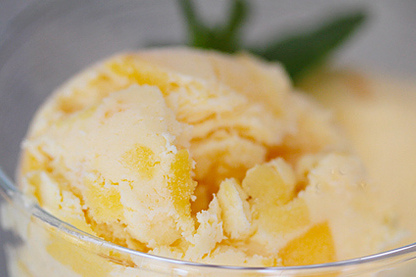
Heavy cashew cream and puréed fruit form the base for this delightful frozen treat. An ice cream maker is required for this recipe.
Ingredients:
• 1 cup (5 oz. by weight) whole raw cashews
• 2 cups non-dairy milk of your choice
• ¾ cup organic sugar
• ½ tsp guar gum
• 2 cups chilled fruit purée, smooth or semi-chunky
Technique:
Place the cashews and milk into a container with a lid, seal and place in the refrigerator to soak for a minimum of 8 hours. After soaking, place the ingredients in a high-powered blender and process on high speed for 2 full minutes.
The cream will now need to be strained to remove the solids. To do this, wash your hands thoroughly and pour the cream into the nut milk bag over a large bowl or pitcher.
While holding the top of the bag with one hand, gently knead the bag to help the cream pass through the ultra-fine mesh – avoid forcing the cream through. Discard or compost the solids in the bag.
Optionally, the cream can be poured (in increments) into a strainer lined with 4 layers of cheesecloth. Stir the cream gently with a spoon to help it pass through the cheesecloth.
Pour the heavy cream into a blender and add the sugar and guar gum; process until smooth. Pour the mixture into a container and refrigerate until very cold (or place in the freezer for about 30 minutes).
When well chilled, pour the cream mixture into your ice cream maker and add the chilled fruit purée. Process the mixture according to your ice cream maker’s instructions.
Print Recipe
Fresh Fruit Ice Cream (Cashew Cream Base)
Votes: 2
Rating: 5
You:
Rate this recipe!
|
|
Votes: 2
Rating: 5
You:
Rate this recipe!
|
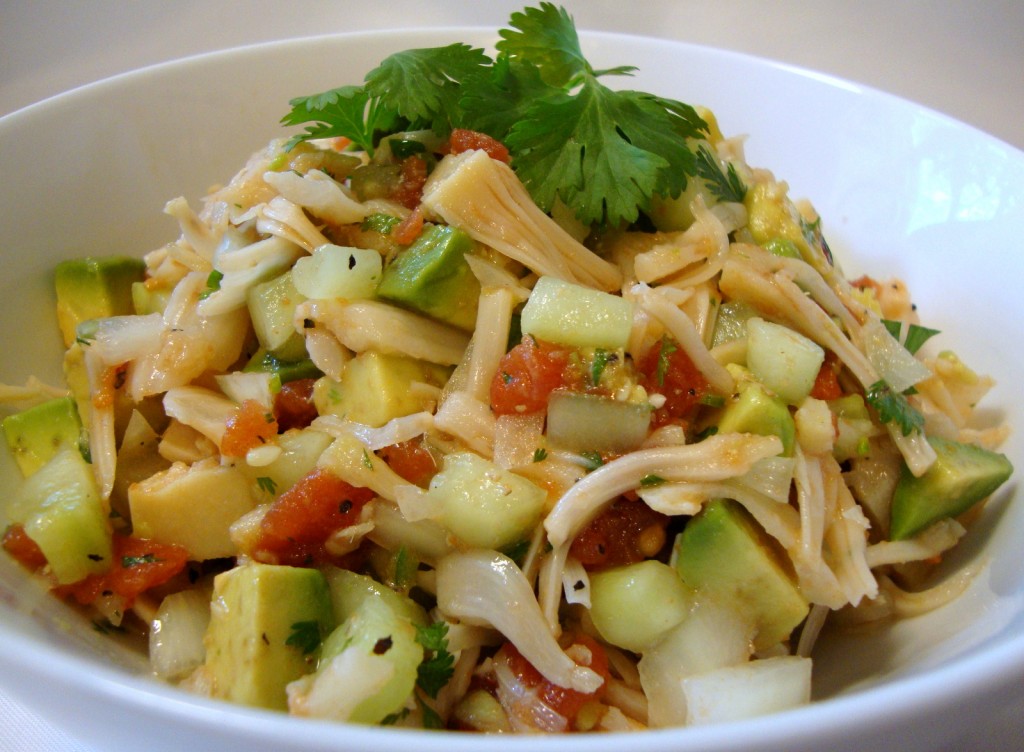 Ceviche (pronounced “seh-VEE-chay”) is a Latin American dish which traditionally consists of raw fish or shellfish marinated in citrus juice (usually lime and/or lemon juice). The acid in the citrus juice coagulates (denatures) the proteins in the seafood, effectively cooking it. Since no heat is used, the dish is served cold. There are many recipe variations combining the marinated fish/shellfish with a wide variety of other fresh ingredients such as onion, tomato, cilantro, chili peppers and avocado.
Ceviche (pronounced “seh-VEE-chay”) is a Latin American dish which traditionally consists of raw fish or shellfish marinated in citrus juice (usually lime and/or lemon juice). The acid in the citrus juice coagulates (denatures) the proteins in the seafood, effectively cooking it. Since no heat is used, the dish is served cold. There are many recipe variations combining the marinated fish/shellfish with a wide variety of other fresh ingredients such as onion, tomato, cilantro, chili peppers and avocado.
My plant-based version relies upon cooked unripe green jackfruit as a replacement for the fish/shellfish, since it has a neutral flavor which takes on the flavor of the marinade and a flaky texture reminiscent of cooked crab. The dish is essentially a zesty, marinated plant-based salad which is served cold as a refreshing appetizer with crispy corn tortilla chips. This recipe yields enough ceviche for 2 to 3 guests; for more simply multiply the recipe.
Ingredients:
• 1 can (20 oz) green jackfruit in water or brine
• ½ cup peeled and small diced tomato
• ½ cup peeled, seeded and small diced cucumber
• ¼ cup small diced onion
• ¼ cup chopped cilantro
• 1 clove garlic, minced
• 1 small Serrano chili, seeded and finely minced
• juice of 1 lime
• 1 T olive oil
• ½ tsp fine sea salt or kosher salt, or more to taste
• ¼ tsp coarse ground black pepper
• ¼ tsp ground cumin
• ½ ripe but firm avocado, diced
*Canned green jackfruit bears a resemblance to flaked crabmeat when cooked. It can be found in Indian and Asian markets or purchased through the internet. Look for the label “Green Jackfruit” or “Young Green Jackfruit” and be sure that it’s packed in water or brine and not syrup. Cans of ripe jackfruit packed in syrup may be stocked nearby, but don’t be tempted to substitute as the ripe fruit will be too sweet for this application.
Chef’s note: Traditional ceviche made with fresh seafood has a fresh, clean flavor and should not be fishy. If you wish to add a subtle ocean flavor to this plant-based version, add a little bit of dried kelp flakes or flaked, toasted nori.
Technique:
Drain the jackfruit and rinse. If the jackfruit was canned in brine, rinse thoroughly. Add the chunks of jackfruit to 1 quart salted boiling water. Reduce the heat to a slow boil and cook for 15 minutes. Drain in a colander and let cool. When cool enough to handle, remove the tough core from each chunk of jackfruit with a sharp knife and discard. Break the chunks apart with your fingers and remove the soft seeds and seed membranes and discard. The remaining flaky pulp is the only portion you will want to use in the dish, so sort through the chunks carefully (there will be a significant amount of unusable material). Wrap the pulp in a lint-free kitchen towel and squeeze to remove excess water. Coarsely chop the pulp and place in a mixing bowl.
Add the remaining ingredients EXCEPT for the avocado and toss well to combine. Refrigerate for several hours to marinate the ingredients and blend the flavors. Add the diced avocado just before serving and toss well. Season the ceviche with additional salt as desired and to taste. Serve with crunchy tortilla chips.
Votes: 4
Rating: 3.25
You:
Rate this recipe!
|
|
Votes: 4
Rating: 3.25
You:
Rate this recipe!
|
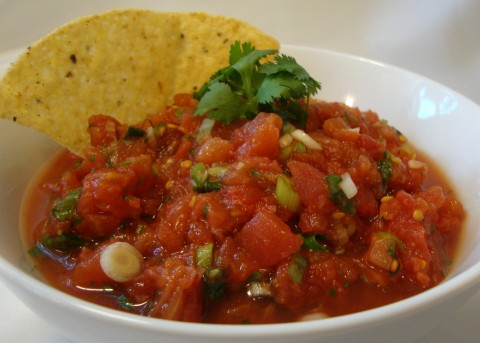
This fresh chunky garden salsa has a medium heat which can be adjusted to suit your taste. I chose canned whole tomatoes because they are partially stewed during the canning process, thus producing a superb texture for salsa. It’s very easy to make and so much better than store-bought. This recipe yields about 4 cups.
Ingredients:
• 2 cans (28 oz each) whole tomatoes
• 3 large scallions or 6 small scallions, white and green parts, finely chopped
• 2 large cloves garlic, finely minced (or 1 for timid palates)
• juice of 1 lime
• 1 small Serrano or jalapeno pepper, finely minced (about 1 T), or more to taste
(for a fiery salsa try including the seeds; for a milder salsa reduce or omit)
• ¼ cup chopped cilantro, or more to taste
• ¾ tsp fine sea salt or kosher salt, or more to taste
• ½ tsp ground cumin
Technique:
Remove the tomatoes from the can and finely dice, reserving any juice in the can for other uses, if desired. The tomatoes themselves contain a great deal of juice, so use a cutting board with irrigation channels if you have one; if not, dice 1 or 2 tomatoes at a time. Place the diced tomatoes in a mixing bowl and toss together with the remaining ingredients. Refrigerate for several hours to blend the flavors, ideally overnight.
Taste and add additional salt before serving, as desired. The salsa will keep for about 10 days in the refrigerator. Serve with your favorite tortilla chips; or use as a topping for your favorite Mexican or Tex-Mex recipes.
Print Recipe
Chef’s Favorite Garden Salsa
Votes: 0
Rating: 0
You:
Rate this recipe!
|
|
Votes: 0
Rating: 0
You:
Rate this recipe!
|
 Crock Beer Cheese is a spreadable sharp non-dairy cheddar enhanced with the flavor of beer. The beer is first reduced to eliminate the alcohol and a good portion of the water thus concentrating its flavor (the beer flavor is not a primary note in the cheese but rather contributes to the overall flavor profile). To spice things up, ground cayenne pepper can be added before cooking the cheese. For a robust cheese, prepared horseradish can be mixed into the cheese after it has set.
Crock Beer Cheese is a spreadable sharp non-dairy cheddar enhanced with the flavor of beer. The beer is first reduced to eliminate the alcohol and a good portion of the water thus concentrating its flavor (the beer flavor is not a primary note in the cheese but rather contributes to the overall flavor profile). To spice things up, ground cayenne pepper can be added before cooking the cheese. For a robust cheese, prepared horseradish can be mixed into the cheese after it has set.









